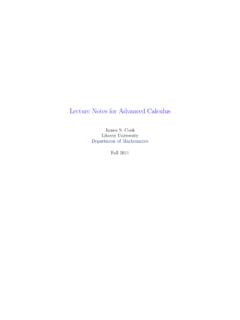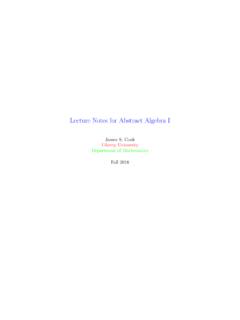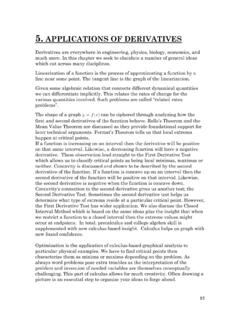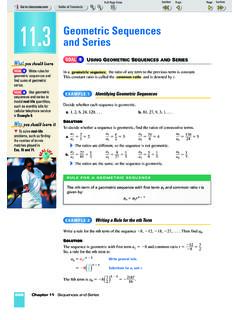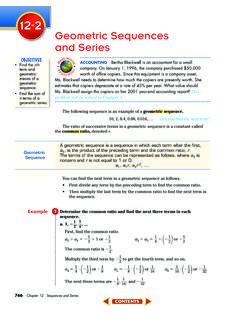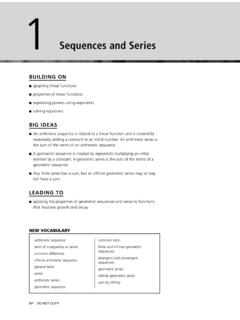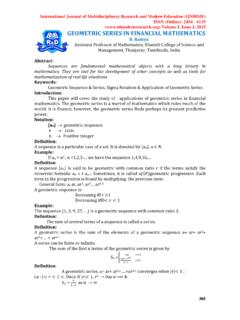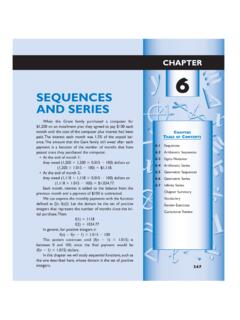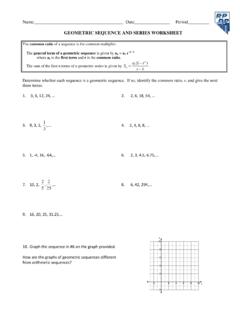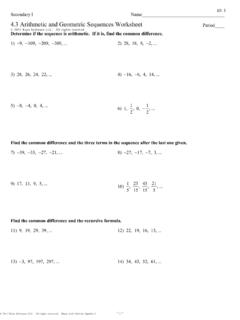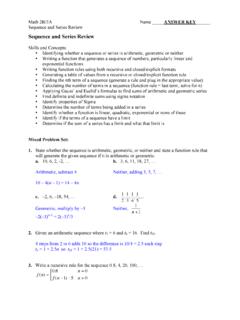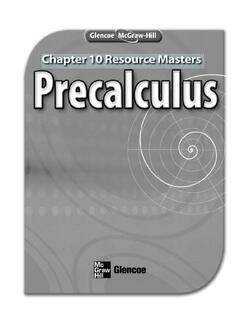Transcription of 11. SEQUENCES AND SERIES - supermath.info
1 27111. SEQUENCES AND SERIES This chapter diverges wildly from everything we have done up to this point. Now more than ever it is important that you not miss any lecture. This chapter is much more about logic and applying theory than algorithmic calculation. For most of you this is not good news. However, don t despair. Just take it one day at a time and you ll get it. It will be easier if you have a good attitude about it. ( I speak from my own experience ) What is our goal? Our goal in this Chapter as well as the two that follow is to find a robust approximation scheme for functions. In particular, we will see how to rewrite most functions as a sort of infinite polynomial. We already took the first step towards this in calculus I, we replaced a function by its linearization.
2 That is a first-order approximation. Next, you can replace a function by a quadratic polynomial, this would be a second-order approximation. If you continue without end you arrive at what is known as a power SERIES . In practice we cannot go on forever on a computer calculation, however we can keep as many terms as we need to arrive at the precision that the problem requires. This Chapter is needed to build us up to the point of understanding how to carefully define a power SERIES . Historically speaking the idea of a power SERIES approximation goes back several centuries and developments in calculus and SERIES / SEQUENCES have been inextricably linked. SEQUENCES form very important examples in the study of limits. Analysis ( careful mathematics built from limiting arguments ) matured historically because it demanded to arrive at a logically consistent treatment of SEQUENCES and SERIES .
3 The better part of the nineteenth century was filled with correcting minor mistakes in the arguments of Newton and Leibniz. Without getting too technical, what happened was that the early fathers of calculus used power SERIES arguments without paying enough attention to what the proper domains should be for the SERIES . Details and domains matter more when you start getting to the edge of what is known. In the nineteenth century astronomy gathered observations of the motion of the planets that were very precise. However, the mathematics of Newton s Universal Law of Gravitation did not allow an exact solution. The problem of figuring out how all the planets pull on each other by the force of gravity is quite complicated. There is the Sun and all the planets, their motions are coupled.
4 Approximations to the real forces have to be used just to make the mathematics workable. However, then you have to make sure the mathematical approximation is not creating error bigger than the error inherent in the measurements themselves. It took a herculean effort by an army of mathematicians and scientists to show that all the motions of the planets were explained beautifully by Newton s Theory. Well everything except for the perihelion of Mercury. Turns out they calculated correctly, Newton s theory was wrong. But, that is a story for another day. Bottom line, power SERIES are an indispensible tool for mathematical sciences. sequence EXAMPLES So what is a sequence ? (by the way, you should read Stewart section , it s cleaner than these notes on certain points and he has lovely pictures) I should emphasize that a sequence is an ordered list of numbers.
5 Examples through Example (Fibonacci sequence ) SEQUENCES naturally occur in computer science. Often those are defined recursively, some loop generates the next value in the sequence from the last. A recursively defined sequence may not have a nice global formula like we say in E1, E2, E3. The Fibonacci sequence is one of the more famous recursively defined SEQUENCES : Generally the pattern is for . To summarize, 273 Example (Silly bonus point example) I ll give you a bonus point if you can crack the definition of the following sequence and tell me the next element beyond those already listed: The next element not listed is fairly well suggested by what is already there, past that I suppose it could repeat, but in principle there are limitless options.
6 Much like being given graph, we can t be certain what happens beyond the given viewing window. Remark: since a sequence is just a function from it follows we can construct new SEQUENCES from old SEQUENCES in many of the same ways as we did for functions. If are SEQUENCES then and are also SEQUENCES . We can also multiply a sequence by a number to obtain a new sequence where the formula for is naturally for each . In contrast, composition of SEQUENCES almost never would make sense as the output of a sequence is real numbers and the outer function of the composite would need inputs of natural numbers. Big Picture Comment: the concept of a sequence is much more general than our examples and this course portrays. Pretty much anything which can be listed in order forms a sequence .
7 We insist that our list be filled with real numbers, but they could just as well be complex numbers, matrices, triangles, or clowns. A sequence in a space is a function from into the space. We will deal exclusively with the simple case of real-valued SEQUENCES in calculus II. (convergence is trickier in spaces other than ) CONVERGENCE OF SEQUENCES SEQUENCES can converge or diverge but not both. We say a sequence converges to if as we go further out the sequence we get values closer to . If this reminds you of our definition of then good, it is the same thing conceptually. There is the definition and notation in words. Let me be a bit more exact. There is a technical formulation of this limit. 274 Technical Definition of Limit of sequence Let be a sequence then we say as iff for each there exists a such that whenever we find.
8 For those of you who are keeping score this is verbatim the definition we gave before for as . The only difference is that the sequence is tested at natural numbers whereas the function is tested at real numbers. Given this observation the following Theorem is quite unsurprising: Stewart makes a fairly big deal about this in various examples. He says you cannot apply L Hopital s Rule to a limit of a sequence . And technically he is correct, but the Theorem above shows that it is not wrong to think of extending the domain of the sequence to the real numbers. I will allow you to apply the Theorem by saying I m extending n to be a continuous variable in the margin when you use L Hopital s Rule. This saves some writing. I suppose I should mention that limits of SEQUENCES also share many of the same properties as limits of functions, we assume in what follows: 275 Example Find the limit of.
9 I can think of about 4 or so somewhat distinct ways to solve this limit. Let s contrast the methods. 1. Use algebra: 2. Use algebra: 3. Use the largest power wins logic: (I m fond of this one) 4. Extending to be a continuous variable we apply L Hopital s Rule to type : 5. Eyeball it: as the denominator is huge compared to the numerator, just look at n=1000 for the answer is zero. When I am taking a limit as part of a larger problem and it is a simple limit like this one I do tend to use 5.) a fair amount. You should only attempt 5.) once you have mastered the other options. I do hope you gather an intuition about these things by the time we are done. For example, I hope you become fluent in the results below 276 Example (the picture illustrates how we can extend a sequence to a function) I know you have missed the squeeze theorem.
10 Good news, its back: Example 277 Example The example that follows is used often in later sections. Example When we study the geometric SERIES this limit will help us stay out of trouble. Increasing and Decrease in SEQUENCES We can study the continuous extension of a sequence if it has a nice formula to extend: 278 Don t get lost in the technicalities here, it s really very simple, a bounded sequence will fit inside some finite horizontal band if we look at large n. This doesn t mean is has to have a convergent limit. Sine and cosine are bounded but they certainly do not converge. We need something more to insure that a bounded sequence will converge. Example Notice that the sequence in E9 is monotonic because it is decreasing everywhere.

